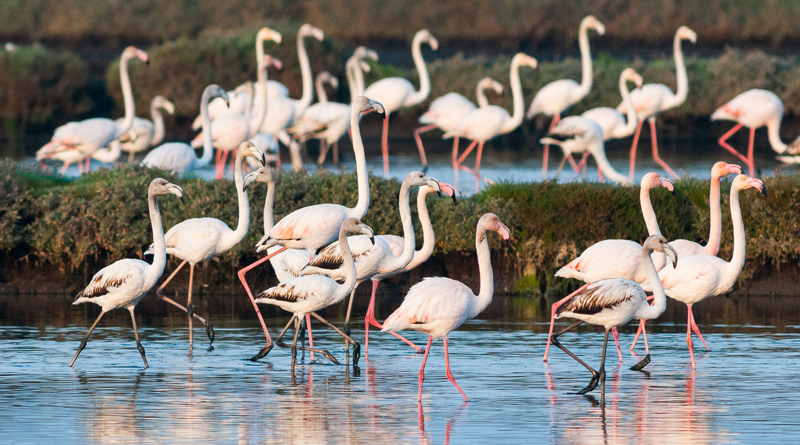BIRD WATCHING AT BIORIA IN PORTUGAL
With over 180 species to see you don’t need to be a wildlife expert to enjoy a walk through the wetlands of The Aveiro Lagoon in Portugal.
The lagoon and its wetlands are fed by the Vouga River, which originates in central Portugal, and the Atlantic Ocean – giving rise two distinct habitats; brackish salt water marshes and fresh water rivers.
Rice is still grown in the area and the BioRia project looks to combine this aquaculture with nature tourism, creating a space for both humans and animals.
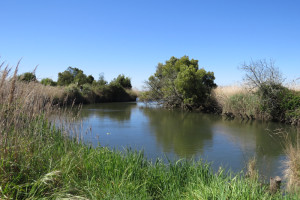 Unlike the typical British nature reserve, which is usually owned and run by an NGO like the RSPB, this is a collection of privately owned plots that are contained within the BioRia project. Pathways and an interpretation/education centre have been created with a café planned in the next couple of years. One of the key aims is environmental education and there are knowledgeable guides on hand to answer any questions or point out birds you might not recognise.
Unlike the typical British nature reserve, which is usually owned and run by an NGO like the RSPB, this is a collection of privately owned plots that are contained within the BioRia project. Pathways and an interpretation/education centre have been created with a café planned in the next couple of years. One of the key aims is environmental education and there are knowledgeable guides on hand to answer any questions or point out birds you might not recognise.
In many ways, this wetland area is reminiscent of the RSPB reserve at Rainham Marshes in Essex – but with better weather. It is situated on the outskirts of the town, overlooked by houses, with a railway line running past. Like Rainham it is an oasis of nature with easily accessible paths that take you deep into the wetland areas. And yes, you will see some of the same species. But don’t think that just because you’ve been to Rainham you’ve ‘done’ BioRia – you certainly haven’t.
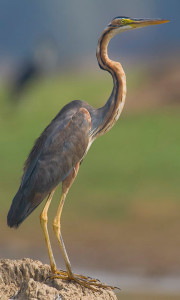 Walking through Bioria-Salreu you are pretty much guaranteed to see the emblematic Purple Heron with its striking orange and black striped head, and the giant black and white Stork – neither of which are a common sight in Essex. You’ll also see Marsh Harriers and Black Kites and if you’re lucky (we were!) an Osprey.
Walking through Bioria-Salreu you are pretty much guaranteed to see the emblematic Purple Heron with its striking orange and black striped head, and the giant black and white Stork – neither of which are a common sight in Essex. You’ll also see Marsh Harriers and Black Kites and if you’re lucky (we were!) an Osprey.
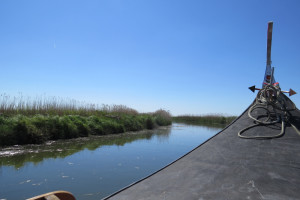 As you follow the path through the wetlands you are accompanied by the cicada like song of the Cisticola, and the deep throated croaking of green frogs swimming among the weeds. Take a trip on one of the traditional Moliceiro boats with their brightly coloured decorative panels and you’re very likely to see flocks of flamingos feeding in the shallow waters of the lagoon.
As you follow the path through the wetlands you are accompanied by the cicada like song of the Cisticola, and the deep throated croaking of green frogs swimming among the weeds. Take a trip on one of the traditional Moliceiro boats with their brightly coloured decorative panels and you’re very likely to see flocks of flamingos feeding in the shallow waters of the lagoon.
The landscape changes as you walk deeper into the ‘reserve’; from tree-lined paths past rice fields, to the tall reeds of the marshes swaying in the breeze, to the dappled trail along the river bank where eels used to be a common sight.
Like so much of Europe’s countryside this area also suffers from the impact of invasive species; in particular, the American Crayfish, and Acacia and Eucalyptus trees.
The Crayfish was originally brought to Spain to be farmed, but some escaped and over the years they have spread across Spain and into Portugal where they are responsible for a steep decline in amphibian numbers. Managing these invaders is a never-ending job – one which we will probably never win.
However, this story does have a silver-lining; the White Stork was almost extinct in the area about 25 years ago, but thanks to a range of conservation interventions numbers have climbed steadily and the birds are now a common site – and they love to eat the American Crayfish. The abundance of the Crayfish means parents have more food for their young, so survival has increased and the populations of Storks now sit at a much healthier level.
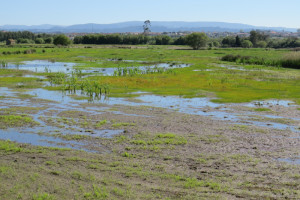 The impact of Acacias and Eucalyptus trees does not have a positive side. These trees were introduced for forestry purposes – they grow fast, so they can be harvested sooner than native species. But they also spread fast – and as seeds can’t be kept to within the plantation areas only, these invaders have naturally spread outside their human-planted areas, seeding themselves across the country. They are a problem as they don’t provide any useable habitat for native species and they degrade the surrounding soil preventing local plants from growing. In other words, they reduce the available habitat for the indigenous plants and animals that need it.
The impact of Acacias and Eucalyptus trees does not have a positive side. These trees were introduced for forestry purposes – they grow fast, so they can be harvested sooner than native species. But they also spread fast – and as seeds can’t be kept to within the plantation areas only, these invaders have naturally spread outside their human-planted areas, seeding themselves across the country. They are a problem as they don’t provide any useable habitat for native species and they degrade the surrounding soil preventing local plants from growing. In other words, they reduce the available habitat for the indigenous plants and animals that need it.
Forest fires are common in Portugal but these trees are more resistant to burning than their native counterparts, and even when a fire has cleared an area the invaders are the first to regrow – taking over the land and preventing the growth of the local flora. Cutting them back encourages growth, and digging them out is difficult as their roots tend to spread far from the trunk of the tree. Another invasive species introduced by humans that is now damaging our natural environment.
Although these species do create problems when it comes to conservation and the preservation of our natural environment – they can’t take away from the beauty and tranquillity of a walk or cycle-ride through the wetlands and along the river banks of BioRia. Instead look at them as an opportunity to learn more about how ecosystems are balanced and what impact humans are having – both negative and positive.
FACT BOX
3rd ObservaRia – Estarreja Birdwatching Fair
TAP Portugal flies direct from London Gatwick to Porto 13 times a week, prices start at £44 one way including all taxes and surcharges. For further information, visit www.flytap.com or call 0345 601 0932
Moliceiro boats
About the Author:
Chantal Cooke is an award-winning journalist and broadcaster. In 2009 Chantal was awarded London Leader in Sustainability status, and in addition to co-founding PASSION for the PLANET. Chantal also runs a successful communications agency – Panpathic Communications.

